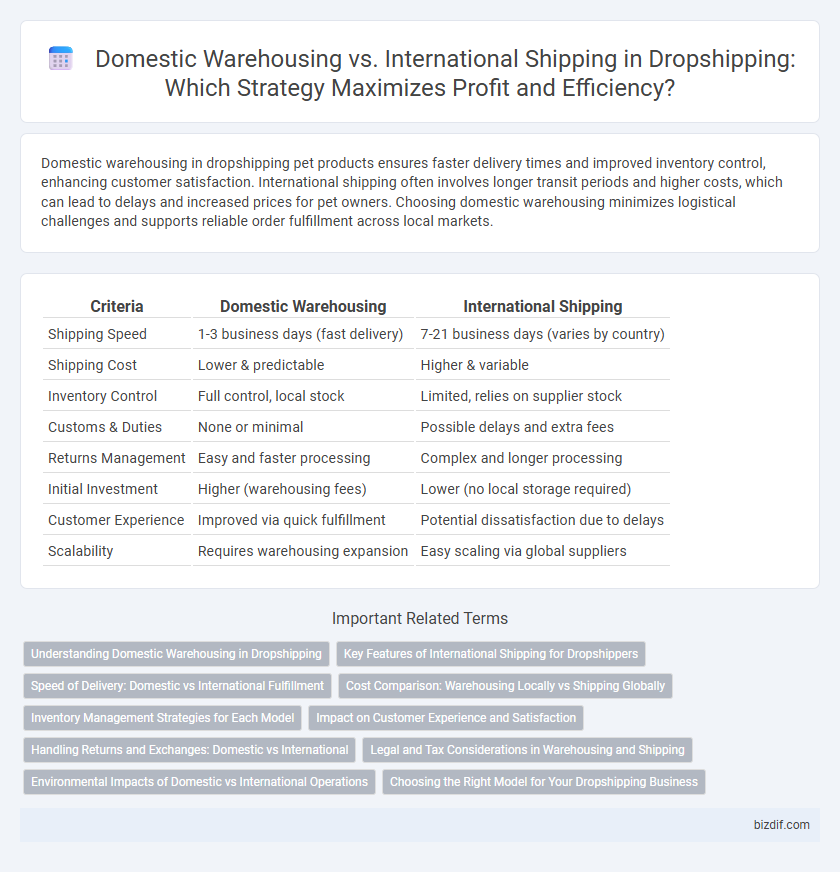Domestic warehousing in dropshipping pet products ensures faster delivery times and improved inventory control, enhancing customer satisfaction. International shipping often involves longer transit periods and higher costs, which can lead to delays and increased prices for pet owners. Choosing domestic warehousing minimizes logistical challenges and supports reliable order fulfillment across local markets.
Table of Comparison
| Criteria | Domestic Warehousing | International Shipping |
|---|---|---|
| Shipping Speed | 1-3 business days (fast delivery) | 7-21 business days (varies by country) |
| Shipping Cost | Lower & predictable | Higher & variable |
| Inventory Control | Full control, local stock | Limited, relies on supplier stock |
| Customs & Duties | None or minimal | Possible delays and extra fees |
| Returns Management | Easy and faster processing | Complex and longer processing |
| Initial Investment | Higher (warehousing fees) | Lower (no local storage required) |
| Customer Experience | Improved via quick fulfillment | Potential dissatisfaction due to delays |
| Scalability | Requires warehousing expansion | Easy scaling via global suppliers |
Understanding Domestic Warehousing in Dropshipping
Domestic warehousing in dropshipping involves storing products within the same country as the target market, enabling faster shipping times and improved customer satisfaction. Utilizing localized warehouses reduces shipping costs and customs delays commonly associated with international shipping, enhancing overall delivery efficiency. This approach supports better inventory management and allows for quicker response to market demand fluctuations in domestic regions.
Key Features of International Shipping for Dropshippers
International shipping for dropshippers involves shipping products directly from overseas suppliers to customers, reducing inventory holding costs and expanding product variety. Key features include longer delivery times, higher shipping fees, and the need for customs clearance, which can impact customer satisfaction and operational efficiency. Leveraging reliable carriers with tracking capabilities and clear communication about shipping policies are crucial for maintaining trust and managing expectations in cross-border dropshipping.
Speed of Delivery: Domestic vs International Fulfillment
Domestic warehousing significantly reduces delivery time by storing products closer to customers, enabling same-day or next-day shipping. International shipping often involves longer transit times due to customs clearance, cross-border logistics, and varying carrier efficiency. Fast delivery through domestic fulfillment enhances customer satisfaction and reduces order abandonment rates in dropshipping operations.
Cost Comparison: Warehousing Locally vs Shipping Globally
Domestic warehousing often reduces shipping costs by minimizing transit distances and enabling faster delivery times compared to international shipping. While international shipping may seem cost-effective for bulk orders, expenses like customs fees, tariffs, and longer delivery windows typically increase overall costs. Evaluating the trade-off between warehousing fees and global shipping charges is essential for optimizing dropshipping profitability.
Inventory Management Strategies for Each Model
Domestic warehousing enables faster order fulfillment and more precise inventory tracking by storing products closer to the customer base, reducing shipping times and enhancing customer satisfaction. International shipping relies heavily on predictive inventory management and accurate demand forecasting to mitigate longer lead times and potential customs delays, often utilizing virtual warehouses or third-party logistics providers to balance stock levels globally. Effective inventory management in dropshipping hinges on aligning stock visibility and replenishment strategies with the chosen warehousing model to optimize turnover rates and minimize holding costs.
Impact on Customer Experience and Satisfaction
Domestic warehousing significantly enhances customer experience by reducing delivery times and enabling faster order fulfillment, which leads to higher satisfaction rates. International shipping, while expanding market reach, often results in longer transit times, customs delays, and increased shipping costs that can negatively impact customer expectations. Optimizing inventory placement through domestic warehouses minimizes logistical issues and improves reliability, directly contributing to an improved overall shopping experience.
Handling Returns and Exchanges: Domestic vs International
Handling returns and exchanges in dropshipping is more efficient with domestic warehousing due to faster processing times and reduced shipping costs, enhancing customer satisfaction. International shipping often involves complex customs procedures, higher return shipping fees, and longer transit times, creating barriers for smooth returns. Businesses leveraging domestic warehouses can streamline reverse logistics, minimizing delays and improving overall return management.
Legal and Tax Considerations in Warehousing and Shipping
Domestic warehousing in dropshipping simplifies compliance with local tax regulations, including sales tax collection and reporting, reducing the risk of audits and penalties. International shipping introduces complex legal requirements such as customs duties, import restrictions, and varying VAT obligations, which can increase operational costs and compliance challenges. Understanding the tax nexus and regulatory frameworks in each target country is essential to optimize warehousing strategies and avoid costly legal issues.
Environmental Impacts of Domestic vs International Operations
Domestic warehousing significantly reduces carbon emissions by minimizing long-distance transportation and enabling more efficient last-mile delivery systems. International shipping relies heavily on fossil fuels for cargo ships and airplanes, contributing to higher greenhouse gas emissions and marine pollution. Emphasizing local storage and fulfillment supports sustainable supply chain practices and lowers the overall environmental footprint of dropshipping operations.
Choosing the Right Model for Your Dropshipping Business
Domestic warehousing offers faster delivery times and improved customer satisfaction by storing products closer to the target market, which reduces shipping costs and delays. International shipping expands product reach and access to global suppliers but often involves longer transit times, higher shipping fees, and complex customs procedures. Selecting the right model depends on balancing speed, cost, and market access to optimize profitability and customer experience in your dropshipping business.
Domestic Warehousing vs International Shipping Infographic

 bizdif.com
bizdif.com